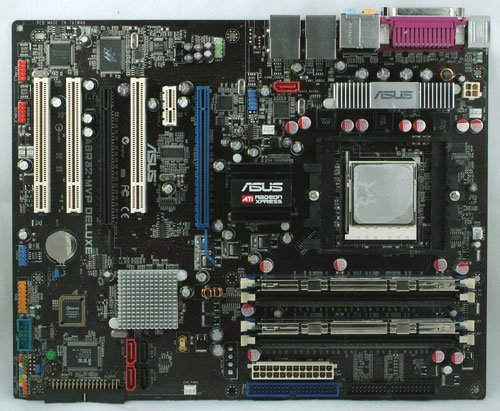
Original Link: https://www.anandtech.com/show/1948
Asus A8R32-MVP Deluxe: First ATI RD580
by Wesley Fink on March 1, 2006 9:00 AM EST- Posted in
- Motherboards
The Asus A8R-MVP created quite a stir when Asus introduced the $100 AMD Socket 939 motherboard based on the ATI RD480 chipset. This was a mainstream motherboard that featured the ULi M1575 Southbridge for full SATA2 3GB/sec drive support and uncompromised USB performance. In addition, the A8R-MVP turned out to be an outstanding overclocker. We were very pleased with the value of the A8R-MVP and praised the board in our A8R-MVP launch review.
However, some realities set in as the A8R-MVP made its way to market in volume. Many complained that a 2T Command Rate was required for overclocks above 260/265 clock speed - something that we initially missed due to 2T being the Auto default on reset of the A8R-MVP. The A8R-MVP was very fast at 2T, but everyone expected that it would be even faster at 1T. In addition, the high overclocks required a slow progression to the overclock speed in 5 to 10 MHz increments, as we had reported in our initial review. We had seen this on other boards, but this overclocking requirement is often a real time-waster with serious overclockers.
The great news with the A8R-MVP was that it had no difficulty whatsoever with ATI Dual x8 Crossfire. The simple paddle design seemed to succeed where more complicated designs often failed with 2 ATI video cards in Crossfire mode. The A8R-MVP, therefore, became the board of choice for ATI Crossfire video.
Fast forward to today's launch of the ATI RD580 chipset. Asus is now shipping the updated Asus A8R32-MVP, which is widely available for purchase at the launch of the ATI RD580 chipset. Asus has certainly updated their ATI chipset board with the RD580 chipset and Dual x16 capabilities to compete with the best AMD chipsets available, but they have done more than merely update the A8R-MVP with a new chipset. Asus has listened to buyers and answered the concerns, complaints, and suggestions of A8R-MVP buyers. The result is an Asus A8R32-MVP that is definitely worth your attention.
We said in our A8R-MVP review that we really hoped that Asus would deliver a super high-end board, much like the Asus A8N32-SLI Deluxe, which is an 8-phase Asus design. The A8R32-MVP is still not that top-end design, but Asus has added enough to the A8R32-MVP to move it to the Deluxe name. When we talked to Asus about the positioning of the A8R32-MVP, they were clear that the board performance had been improved and the board is a superb overclocker. However, we will likely not see the full-blown treatment until the AM2 version of the A8R32.
In checking with other major motherboard manufacturers, DFI and Abit will be launching top-end RD580 motherboards, but many vendors like MSI and ECS will not have an RD580 offering until the AM2 launch. This makes some sense, since RD580 fully supports AM2 and AM2 is now expected within 3 months of this official RD580 launch. However, we are grateful that Asus, DFI and Abit decided to go ahead with a Socket 939 version of RD580, since it is looking as if RD580 will be an outstanding chipset for the AMD processor.
Two things stand out about the Radeon Xpress 3200 chipset:
- RD580 is a true Dual x16 PCIe design with both x16 PCIe slots off the north bridge.
- The RD580 was designed from the ground up for high-speed overclocking. In fact, most RD580 boards will be able to run at around 300 clock frequency at the base 5X (1000) HTT frequency instead of having to drop to 3X (600) as on other chipsets.
Asus A8R32-MVP: Board Layout
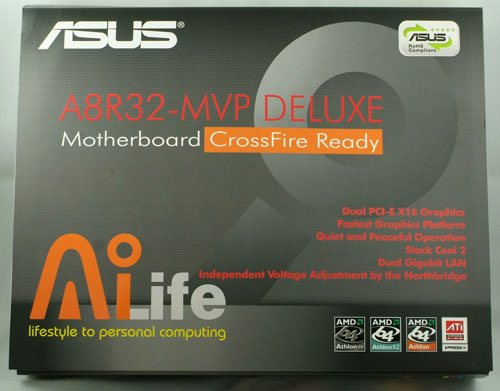
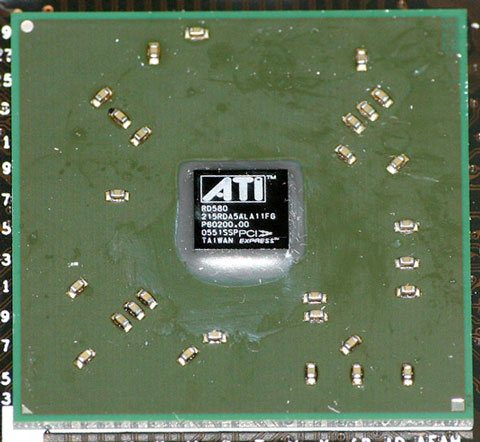
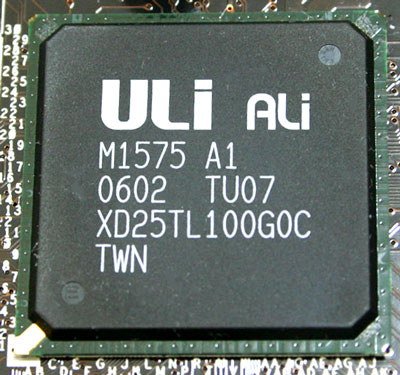
Since the A8R32-SLI Deluxe is an upgrade to the current A8R-MVP, the best way to compare the two boards is to take a closer look at what has changed in the upgrade.
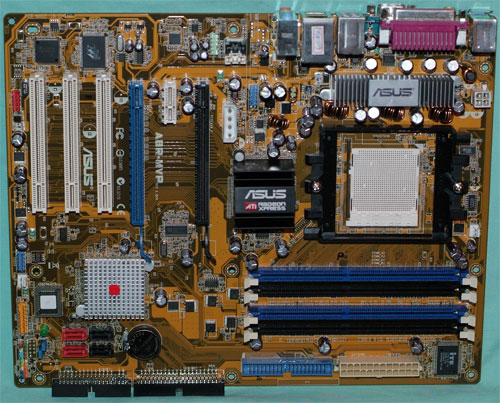
The only other layout change of any significance involves the PCIe slots. Asus has spread the 2 PCIe slots to a distance of 2 slots between the two x16 slots. This allows better video card cooling. It also requires a slight rearrangement of the available slots, but the total slots - 2 x16 PCIe, 1 x1 PCIe, and 2 PCI - remains the same.
If you look closely, you will see that the RD580 does not need a supplementary 4-pin Molex connection like the earlier 480, and that connector has been removed from the A8R32-MVP. We had no problems with stability of 2 video cards, even with dual X1900XT video cards, so the extra power connection is not necessary for stable dual video on the A8R32-MVP.
The rest of the updates to the A8R32-MVP Deluxe are not so obvious at first look.
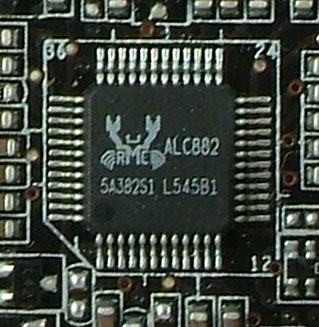
The ALC882 has superb specifications, providing five 24-bit stereo DACs and three 20-bit stereo DACs driving the multimedia features. All DACs provide sample rates to 192kHz and up to 4 channels of microphone input are supported. Signal-to-Noise ratio is specified to be greater than 103dB. Realtek features the ALC882 as a premium HD part.
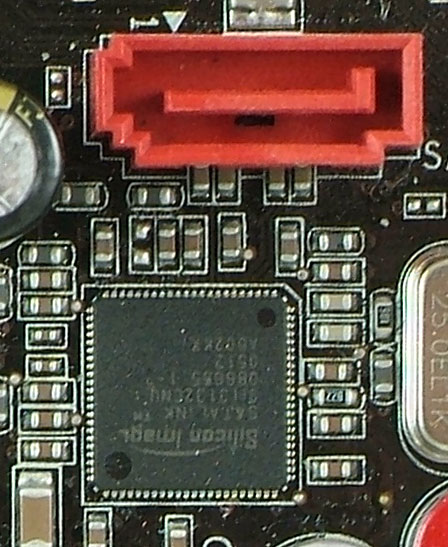
Another addition that justifies the Asus move of the A8R32-MVP to the Deluxe moniker is the addition of a second Gigabit LAN. Where the A8R has just the slower PCI Gigabit Ethernet, the A8R32 adds a second full-speed Gigabit LAN on the PCIe bus. This will be an important addition for some buyers.

The refinements to the A8R32-MVP Deluxe layout are subtle, but they improve on the already excellent design of the A8R-MVP. Asus has a reputation for paying attention to details in their board layouts, and they do not disappoint with the A8R32-MVP.
Basic Features: Asus A8R32-MVP
| Asus A8R32-MVP Deluxe | |
| CPU Interface | Socket 939 Athlon 64 |
| Chipset | ATI RD580 Northbridge - ULi M1575 Southbridge |
| Bus Speeds | 200 to 400MHz in 1MHz Increments |
| Memory Speeds | DDR200,266,333,366,400 (433,466,500 with Rev. E AMD) |
| PCIe Speeds | 100 to 150MHz in 1MHz Increments |
| PCI/AGP | Fixed at 33/66 |
| Core Voltage | Auto, 0.8V to 1.4V-1.55V* in 0.025V increments PLUS 0.1V & 0.2V with vCore Over-Voltage (Maximum vCore 1.6V to 1.75V) *Max Voltage depends on CPU ID. To 1.55V with Clawhammer |
| CPU Clock Multiplier | 4x-25.5x in 0.5X increments |
| DRAM Voltage | Auto, 2.6V to 3.2V in .05V increments |
| HyperTransport Frequency | 1000MHz (1GHz) (Stable in overclocking to 1500+ HT) |
| HyperTransport Multiplier | Auto, 1X to 5X |
| Northbridge Over-Voltage | Auto, Disabled, Enabled Enabled adds 3 New Voltage Options Below |
| Core Voltage | 1.2V, 1.3V, 1.4V, 1.5V |
| HyperTransport Bus Voltage | 1.2V, 1.3V, 1.4V, 1.5V |
| PCI Express Voltage | 1.2V, 1.3V, 1.4V, 1.5V |
| Southbridge Overvoltage | Auto, Disabled, Enabled (+0.1V) |
| PEG Link Mode | Auto, Disabled, Normal, Fast, Faster |
| PEG Buffer Length | Auto, Short, Long, Longer, Longest |
| AI Overclocking | Manual, Auto*, Standard*, Overclock Profile**, AI N.O.S.** *CPU Frequency and Other OC Parameters Set Automatically **Manually Set CPU Frequency and Other Parameters Auto Adjust |
| Overclock Profile Options | OC 3%, 5%, 10%, 15%,20%,30% |
| AI N.O.S. Options | OC 3%, 5%, 7%, 10%, 15%, 20% |
| Memory Slots | Four 184-pin DDR DIMM Slots Dual-Channel Configuration Regular Unbuffered or ECC Memory to 4GB Total |
| Expansion Slots | 2 PCIe x16 1 PCIe x1 3 PCI Slots |
| Onboard SATA/RAID | 4 SATA2 Drives by ULi M1575 (RAID 0,1,1+0,5,JBOD) PLUS 2 SATA2 Drives by Silicon Image 3132 (RAID 0,1) |
| Onboard IDE/IDE RAID | Two Standard ATA133/100/66 (4 drives) |
| Onboard USB 2.0/IEEE-1394 | 8 USB 2.0 ports supported by ULi M1575 2 Firewire by TI 1394a |
| Onboard LAN | PCIe Gigabit by Marvel Yukon 88E8053 PCI Gigabit by Marvel 88E8001 |
| Onboard Audio | Azalia HD Audio by Realtech ALC882 codec |
| BIOS Revision | AMI 307 (2/15/06) |
The BIOS adjustments of the A8R-MVP were a pleasant surprise for a low-end board, but they were not as extensive as those seen on top-end Asus boards like the 8-phase A8N32-SLI. The BIOS for the A8R32-MVP is very complete, and does not really have any Asus high-end adjustments missing at all. The available adjustment ranges have been improved over the available options on the A8R-MVP, and Asus has added more options for processor and chipset voltages.
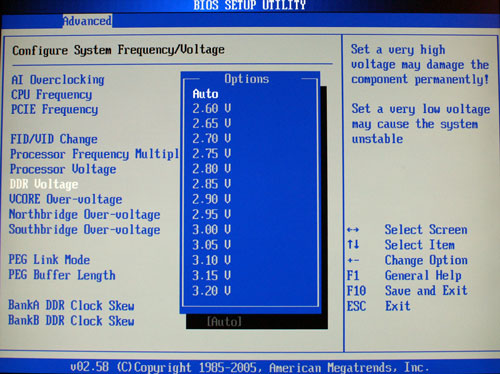
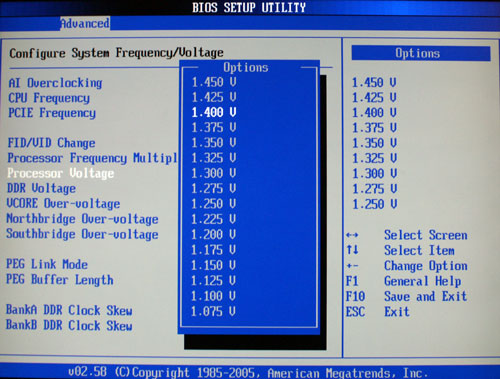
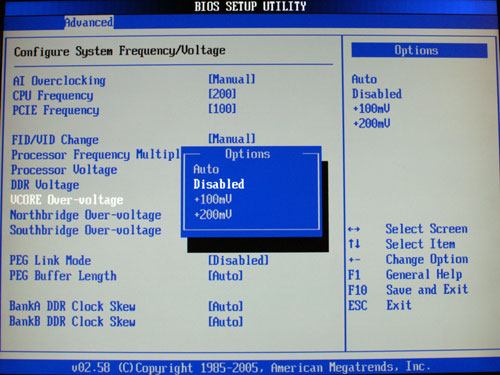
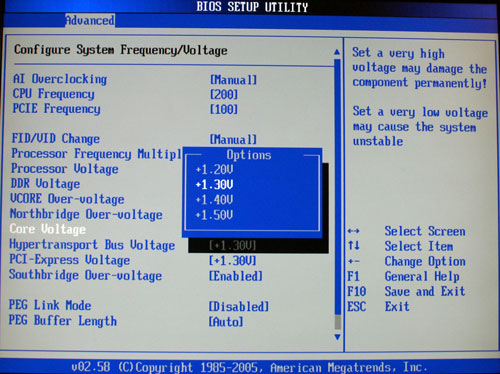
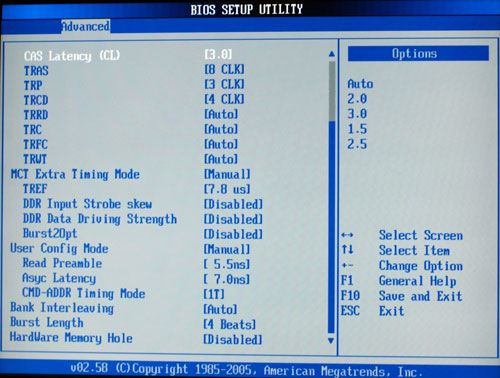
The RD480-based Asus A8R-MVP has a very wide range of overclocking controls for a board in the $100 price range, but it is weak in voltage adjustments and memory Command Rate settings. The RD580-based A8R32MVP, for the most part, corrects those deficiencies by providing finer adjustments, a larger number of BIOS-adjustable voltages, and higher vCore settings. Most users will be pleased with the additions and refinements. The A8R32-MVP stands up well against just about any overclocking board available in terms of the available overclocking options and the range of control available. The Asus designers did an excellent job of listening to buyers of the earlier A8R-MVP and adding the most asked-for improvements.
Overclocking: Asus A8R32-MVP
| Asus A8R-MVP Overclocking Testbed | |
| Processor: | Athlon 64 4000+ (2.4GHz, 1MB Cache) |
| CPU Voltage: | 1.425V (default 1.35V) |
| Cooling: | Thermaltake Silent Boost K8 Heatsink/Fan |
| Power Supply: | OCZ Power Stream 520W |
| Memory: | OCZ PC4800* Platinum (Samsung TCCD Memory Chips) *The current equivalent OCZ memory to OCZ PC3200 Platinum Rev. 2 |
| Hard Drive: | Hitachi 250GB 7200RPM SATA2 8MB Cache |
| Maximum OC: (Standard Ratio) |
246x12 (5x HT, 2.5-3-3-7) 2952MHz (+23%) |
| Maximum FSB: (Lower Ratio) |
322 x 9 (4x HT, 1T, 3-3-4-7) (2898MHz, 2 DIMMs in DC mode) (+61% Bus Overclock) |
One of the most interesting new features in overclocking the RD580 is that the chipset is designed for high-speed operation. In most cases, current NVIDIA and ATI chipsets need to have Hyper Transport frequency adjusted to 3X around a 260 to 270 Clock frequency to keep HT speed at or below 1000-1100. The RD580 chipset was designed for higher HT speed. We consistently found that the board could easily handle HT speeds in the 1450 to 1550 range. For most overclocking this means, for the first time, that it is not necessary to even adjust the 5X HT setting for most overclocks. It was only where we were exceeding around 1500 (300 Clock Frequency) that we had to drop the HT one notch to 4X. Overclockers should be very happy with this new feature of the RD580 chipset.
One word of caution: it appears that the RD580 chipset will not reset an HTT strap or ratio unless you first power down. We had seen this in other testing of the RD580 and it is also a reality on the Asus A8R32-MVP. For instance, if you try to set the ratio to 4X (from 5X), the board will not implement the ratio change until you have powered down the system. Thankfully, this will rarely be necessary with the high-speed HTT capabilities of the RD580, but please keep this in mind when adjusting HTT ratios.
The Asus A8R32-MVP required no special approaches to achieve high overclocks. There is no longer the need to inch your way up on overclocks. High overclocks could be set directly, and as long as the settings were workable, it is possible to boot directly into Windows XP at the higher overclocks. However, there were many times when we set reasonable overclocks and the board failed to boot the first time. In this case, power down the board and restart, and your settings will likely work. Similarly, a bad overclock almost always requires that you turn off the power and restart for recovery. Fortunately, the Asus normally recovers, but often you will need to power off first with overly aggressive OC settings.
The 1T command Rate, which was an issue on the A8R-MVP, is definitely working as you would expect on the A8R32-MVP. We confirmed with memtest86 on boot and Systool in Windows that we were setting and maintaining a 1T Command Rate in high overclocks. We did find that Asus is using a very clever tool to protect the board when settings outside the board's capabilities are detected. If we set values (Ratio and Clock Speed) that would result in an HTT higher than the board's capability of about 1500, the board would read 1T Command Rate in memtest86 (prior to Windows boot) and then change to 2T in Windows. Apparently, Asus is lowering the Command Rate to allow a boot under impossible circumstances - after the BIOS initialization. This was never a problem if you kept the resultant HTT within the board's very wide capabilities, but you should definitely find out where HTT fails to effectively overclock the A8R32-MVP.
Asus has also introduced a very unique and effective new means of dynamically adjusting memory timings for the widest possible compatibility. Asus has developed a means of dynamically controlling memory clock skew to achieve better memory compatibility and better overclocks. The best way to illustrate this feature is with a diagram.

The Asus A8R32-MVP does appear very flexible in handling different memories at default settings, and the overclocking performance at 1T is outstanding. These are certainly indications that Dynamic Clock Skewing is working as claimed. However, some overclocking purists will not be happy with any scheme that second guesses their overclocking settings. For maximum manual control Asus has included BIOS switches for turning off the auto memory clock skew.
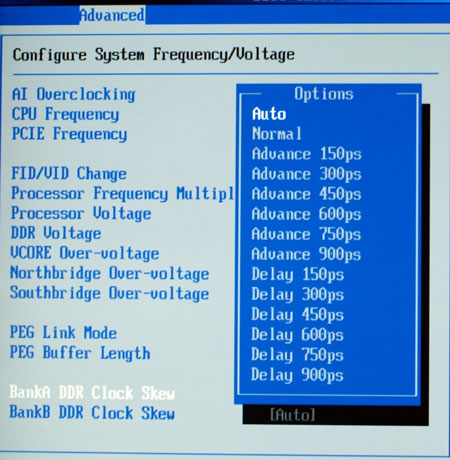
Those who don't understand overclocking or who don't want to bother will find automatic overclocking options in the Asus BIOS. This allows you to set an overclock and have the board adjust the related settings. These work well for moderate overclocking, but they will not allow the extreme results achieved manually on the Asus A8R32-MVP.
Optimum tRAS
In past reviews, memory bandwidth tests established that a tRAS setting of 11 or 12 was generally best for nForce2, a tRAS of 10 was optimal for the nForce3 chipset, a tRAS of 7 was optimal for the nForce4/ATI RD480/ULi M1697 chipsets, and a tRAS of 10 produced the best bandwidth on the ULi 1695.
Since this is our first review of a board with the new ATI RD580 chipset, tRAS timings were first tested with memtest86, a free diagnostic program with its own boot OS that will boot from either a floppy disk or optical disk. Bandwidth of OCZ PC3200 Platinum Rev. 2, based on Samsung TCCD chips, was measured from tRAS 5 to tRAS 15 to determine the best setting.
| Memtest86 Bandwidth Asus A8R32-MVP with Athlon 64 4000+ |
|
| 5 tRAS | 1879 |
| 6 tRAS | 1879 |
| 7 tRAS | 1999 |
| 8 tRAS | 2043 |
| 9 tRAS | 1999 |
| 10 tRAS | 1958 |
| 11 tRAS | 1958 |
| 12 tRAS | 1879 |
| 13 tRAS | 1870 |
| 14 tRAS | 1843 |
| 15 tRAS | 1807 |
The tRAS setting that produced the highest memory bandwidth with the ATI RD580 chipset was 8. The tRas 8 setting was used for all memory testing on the Asus A8R32-MVP Deluxe.
Memory Stress Testing
The Asus A8R32-MVP easily handles 2-2-2-8-1T timings at stock speed. The default setting for Command Rate in the Asus BIOS is 1T, which makes it much easier to assure that the A8R32-MVP consistently delivers top performance than the 2T default seen in the earlier A8R-MVP. We are pleased that Asus decided to implement the more sensible 1T timings in the update to the A8R-MVP.
Running four double-sided 512MB or 1GB DIMMs is much more demanding than running two DS DIMMs, and Asus did not have any special magic here. Like every board that we have tested, except the DFI RDX200, we needed to drop the Command Rate to 2T with 4 DS DIMMs. This really should not be a surprise, since the DIMM timing is primarily a function of the memory controller on the AMD processor. With 4 DIMMs, the A8R32-MVP remained stable with the same aggressive 2-2-2-8 timings that worked best for two DS DIMMs.
| Stable DDR400 Timings - 4 DIMMs (4/4 DIMMs populated) |
|
| Clock Speed: | 200MHz |
| CAS Latency: | 2.0 |
| RAS to CAS Delay: | 2T |
| RAS Precharge: | 8T* |
| Precharge Delay: | 2T |
| Command Rate: | 2T |
Test Setup
| Performance Test Configuration | |
| Processor(s): | AMD Athlon 64 4000+ (2.4GHz) Socket 939 |
| RAM: | 2 x 512MB OCZ PC3200* Platinum Rev. 2 *The current equivalent OCZ memory is OCZ PC4800 |
| Hard Drive(s): | Seagate 120GB 7200 RPM SATA (8MB Buffer) |
| Video AGP & IDE Bus Master Drivers: | ATI 6.2 Catalyst NVIDIA 6.70 |
| Video Card(s): | MSI X1900XT ATIX1900XT Crossfire MSI NVIDIA 7800GTX MSI NVIDIA 7800GTX SLI |
| Video Drivers: | ATI Catalyst 6.2 NVIDIA nForce 81.98 Release |
| Operating System(s): | Windows XP Professional SP2 Direct X 9.0c |
| Motherboards: | Asus A8R32-MVP (ATI RD580/ULi1575) Asus A8R-MVP (ATI RD480/ULi1575) Asus A8N32-SLI Deluxe (nF4 Dual x16) DFI LANParty UT RDX200 (ATI RD480/SB450) DFI LANParty nF4 SLI-DR (nForce4) |
Tests used OCZ PC4800 Platinum (current equivalent to standard OCZ PC3200 Platinum Rev. 2), which uses Samsung TCCD chips. All memory ran at 2-2-2-8 timings in all benchmarks.
We tested with the NVIDIA 7800GTX on the Asus A8R32-MVP to provide test results that could be compared to the most up-to-date performance results. Resolution in all benchmarks is 1280x1024x32 unless otherwise noted. 3DMark and Aquamark3 benchmarks use "Standard Score" setup, which is 1024x768 video resolution.
We also tested using the latest ATI X1900XT to provide comparison results to the NVIDIA 7800GTX. Additional ATI Crossfire testing was performed on the Asus A8R32-MVP at a resolution of 1600x1200, with antialiasing and anisotropic filtering, to provide comparison results to the Asus A8N32-SLI NVIDIA SLI results - NVIDIA Dual x16 to ATI Dual X16.
The NVIDIA 7800GTX and ATI X1900XT are readily available for purchase in the marketplace. Since the 7800GTX 512 is not available for sale anywhere and has not been available for weeks, it seemed unfair to compare x1900XT results to products that are not available for purchase.
Results for the Asus A8R32-MVP are in light green for 7800GTX, orange for X1900XT, and red for x1900XT Crossfire. Similarly, test results for the Dual x16 NVIDIA Asus A8N32-SLI are in light green for the single 7800GTX and dark green for 7800GTX SLI. Results for other boards in the comparisons are light blue and represent test results with a 7800GTX.
General Performance
There is little in the performance of the Asus A8R32-MVP in Winstone benchmarks that stands out. The Asus board is competitive with the best Socket 939 Athlon 64 boards that we have tested. We have already established in past motherboard reviews that the ATI chipset competes well with other AMD chipsets.
With the Memory Controller on the Athlon 64 processor, Winstone benchmarks are no longer very revealing of motherboard performance. In fact, we see boards that are tweaked for best gaming performance are often near the bottom of a tight range of benchmark performance numbers. The Winstone tests themselves are rapidly becoming dated, and are no longer supported by ZD Labs or Veritest. While Winstones are still useful in providing real world performance data, we will be dropping them from our motherboard test suite soon.
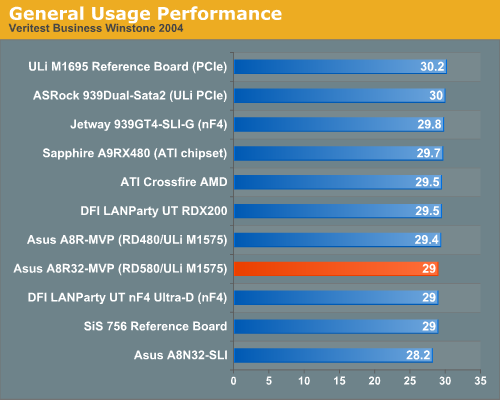
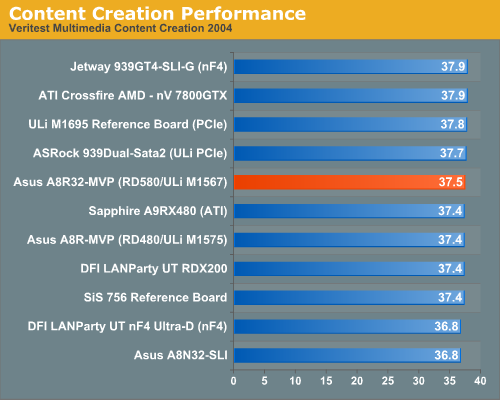
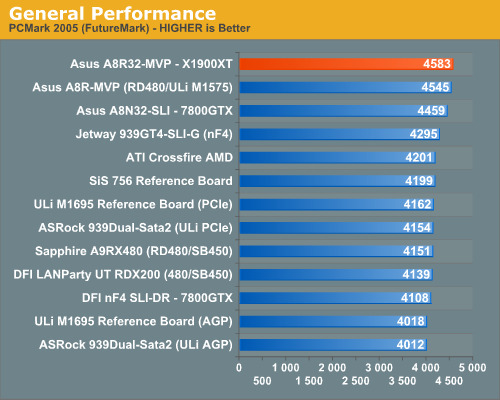
We were never completely comfortable with PCMark04, but PCMark05 is proving to be a much more useful overall performance benchmark. It is generally more sensitive than the older Winstones and PCM04 to recent improvements in PC architecture. PCMark05 results, in general, relate well to the other performance results that we find in our board tests - providing a quick and reliable snapshot of board performance compared to other motherboards.
Graphics Performance and Encoding
The 3DMark benchmarks, published by FutureMark, are probably the most widely quoted gaming performance benchmarks available. While the benchmarks are based on game sequences written by FutureMark to reveal subtle differences in gaming performance, they still have to be considered synthetic benchmarks. They are useful for broad Graphics comparisons, but they are no substitute for benchmarks with real gaming engines that are currently being played.
3DMark06 was recently introduced and you can find more in-depth information about this new 3DMark at in the AnandTech article Futuremark's Latest Attempt: 3DMark06 Tested.
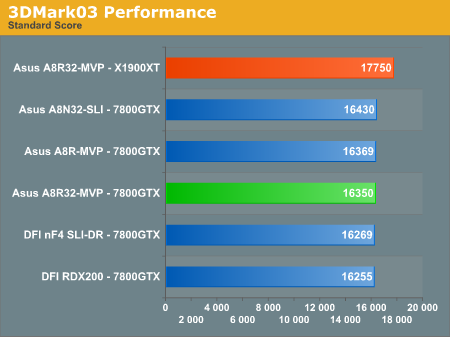
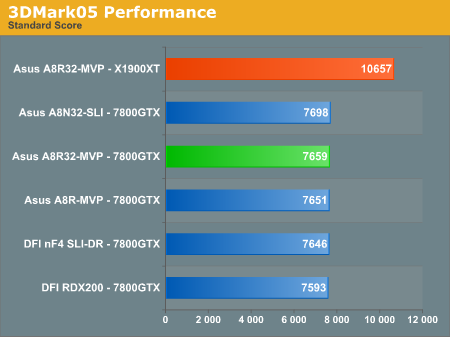
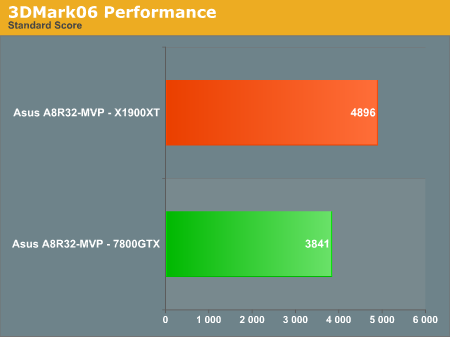
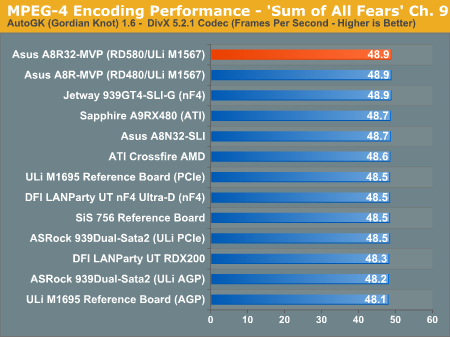
Standard Gaming Performance
We tested with our standard group of game tests, which includes Quake 4, Aquamark 3, F.E.A.R, Far Cry, Splinter Cell – Chaos Theory, Doom 3, and Wolfenstein-Enemy Territory. All boards were tested with the Stock MSI 7800GTX with 81.98 drivers to allow direct comparison of motherboard gaming performance. Benchmarks were also run using the latest ATI X1900XT video card on the Asus A8R32-MVP Deluxe for comparison and to provide a baseline for future performance tests.
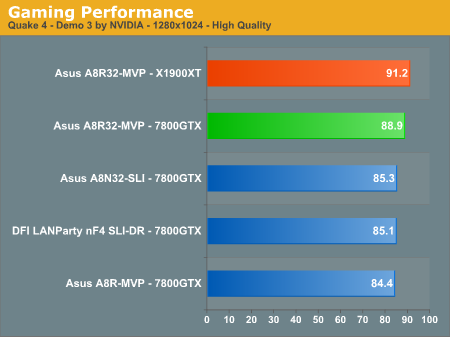
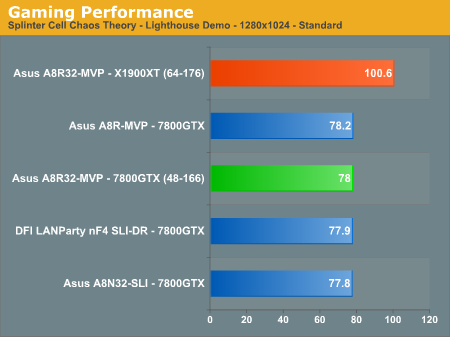
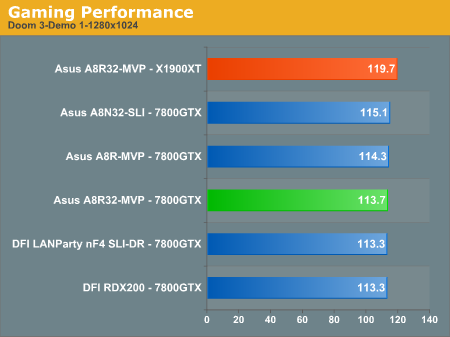
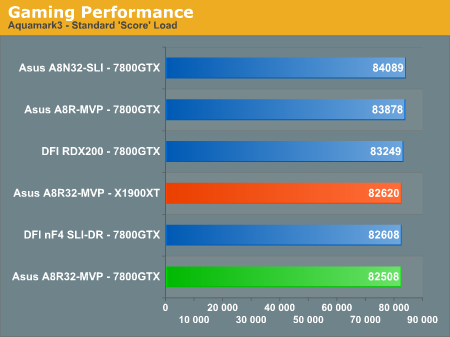
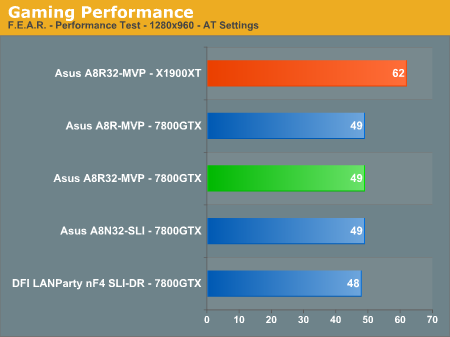
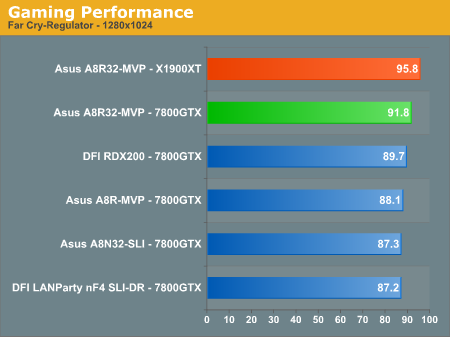
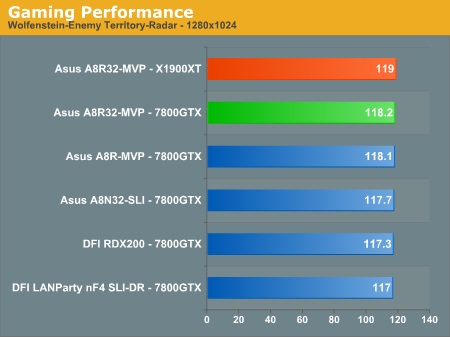
Crossfire Gaming Performance The RD580 chipset brings ATI Dual X16 Crossfire video to the marketplace, so both the major players in the Video market now have flagship Dual X16 solutions. SLI and Crossfire are about gaming, so Crossfire tests were confined to gaming benchmarks, and the test suite is heavily slanted to recent and popular titles where SLI and Crossfire make the biggest difference.
Single Video
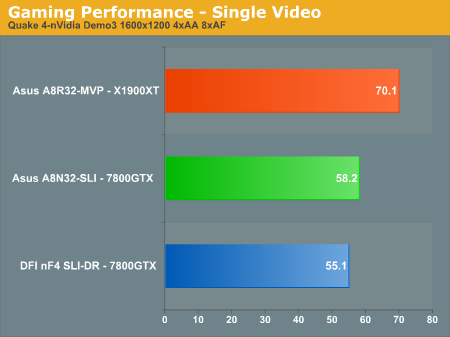
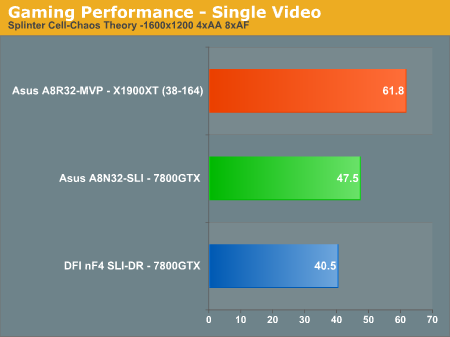
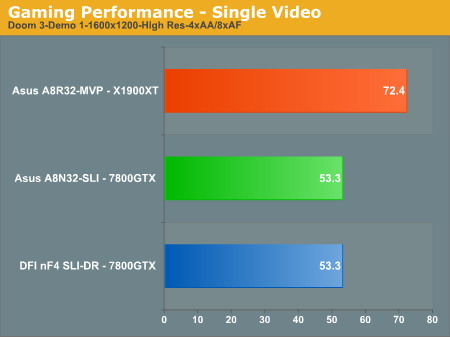
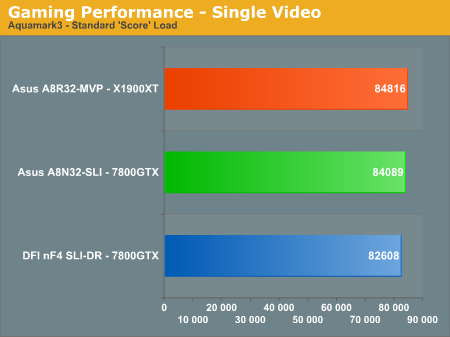
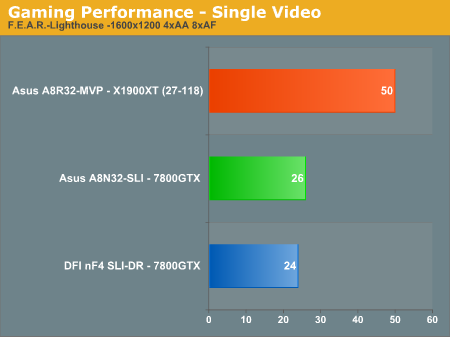
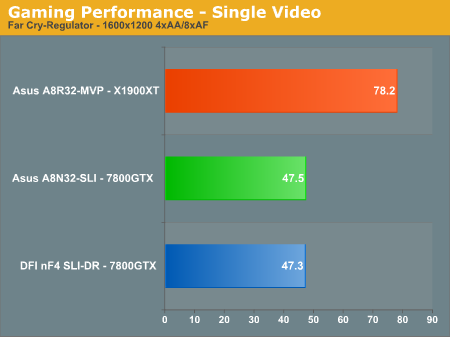
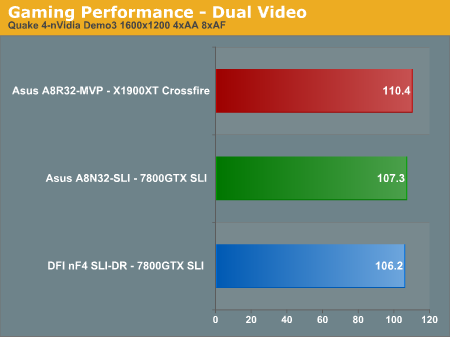
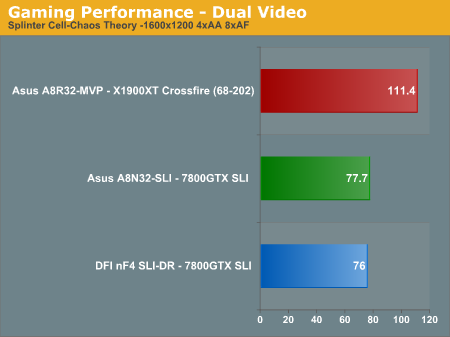
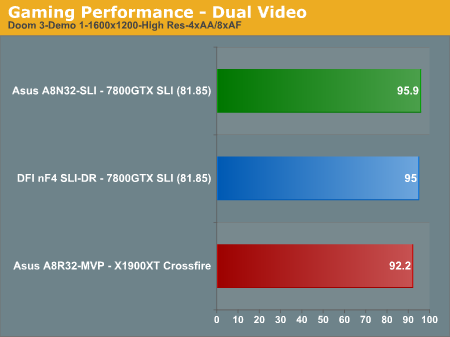
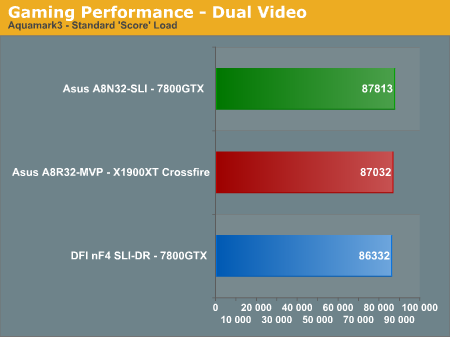
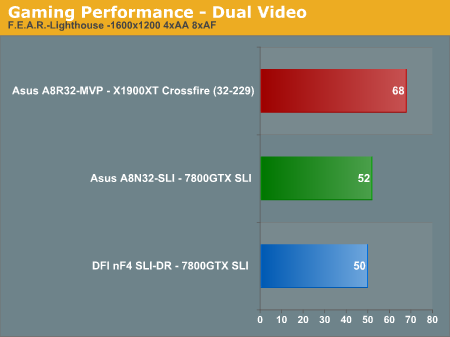
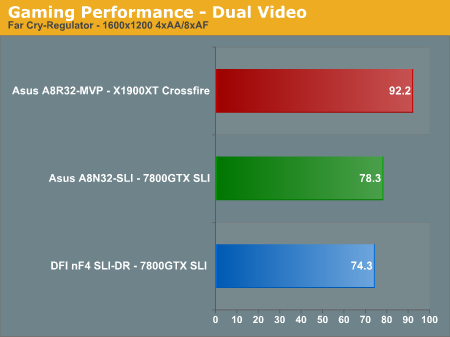
Clearly, with 4X AA turned on at 1600x1200 resolution, the X1900XT outpaces the 7800GTX. X1900XT Crossfire is also the clear winner, but the sweep is not complete as NVIDIA still leads or is razor-close in the Open GL games. The Asus A8R32-MVP ran the single NVIDIA 7800GTX, the X1900XT, and X1900XT Crossfire with no problems at all.
It should be pointed out, however, that ATI has a very clumsy means of enabling Crossfire – and there is nothing intuitive about it. You must install Catalyst Control Center for Crossfire to work. You then go into CCC, select the Crossfire tab and enable the feature. NVIDIA warns you that an SLI-capable system is installed and prompts you to enable SLI. There is no warning at all with ATI. The only clue you will have that Crossfire is not turned on is the poor performance results.
Overclocking
Last year, maximum overclock data was added to our Performance graphs The overclocking performance graphs allow a visual comparison of the overclocking capabilities of tested boards. For more details on the specific overclocking abilities of a specific board, please refer to the Overclocking and Memory Stress Test section of individual board reviews.
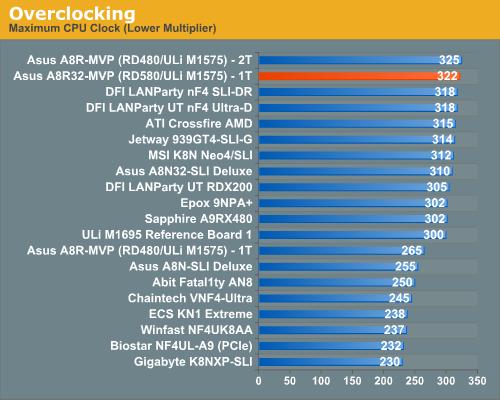
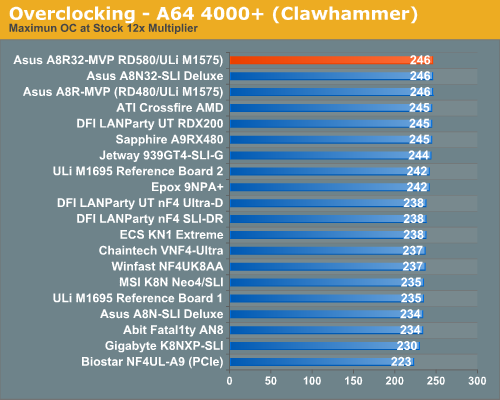
USB Performance
USB has been a problem area for the ATI SB450 chipset, but it has not been a major issue with the ULi M1575 southbridge. To test performance of USB on the A8R32-MVP, we ran our standard USB throughput test using an external USB hard drive.
Our test method uses a RAM disk as our “server”, since memory removes almost all overhead from the serving end. We also turn off disk caching on the USB and Firewire side by setting up the drives for “quick disconnect”. Our results are then consistent over many test runs.
We use just 1GB of fast 2-2-2 system memory, set up as a 450MB RAM disk and 550MB of system memory. Our stock file is the SPECviewPerf 8.01 install file, which is 432,533,504 bytes (412.4961MB). After copying this file to our RAM disk, we measure the time for writing from the RAM disk to our external USB 2.0 or Firewire 400 or Firewire 800 drive using a Windows timing program written for AnandTech by our own Jason Clark. The copy times, in seconds, are then converted into Megabits per second (Mb) to provide a convenient means of comparing throughput. Higher Rates therefore mean better performance.
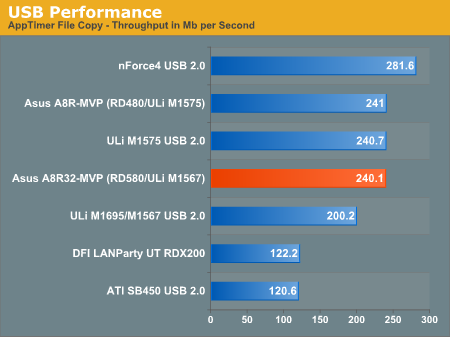
In addition to competitive USB performance, the M1575 also provides the SATA2 ports missing from the ATI SB450. The ULi SATA2 also supports RAID 0, 1, 0+1, 5, and JBOD.
Disk Controller Performance
The AnandTech iPeak test was designed to measure "pure" hard disk performance using the Intel iPeak benchmark. The hard drive is kept as consistent as possible while varying the hard drive controller. The idea is to measure the performance of a hard drive controller with a consistent hard drive.
We played back Anand's raw files that recorded I/O operations when running a real world benchmark - the entire Winstone 2004 suite. Intel's iPEAK utility was then used to play back the trace file of all IO operations that took place during a single run of Business Winstone 2004 and MCC Winstone 2004. The drive was formatted before each test run and a composite average of 5 tests on each controller interface was tabulated in order to ensure consistency in the benchmark.
iPeak gives a mean service time in milliseconds; in other words, the average time that each drive took to fulfill each IO operation. In order to make the data more understandable, we report the scores as an average number of IO operations per second so that higher scores translate into better performance. This number is meaningless as far as hard disk performance is concerned as it is just the number of IO operations completed in a second. However, the scores are useful for comparing "pure" performance of the storage controllers in this case.
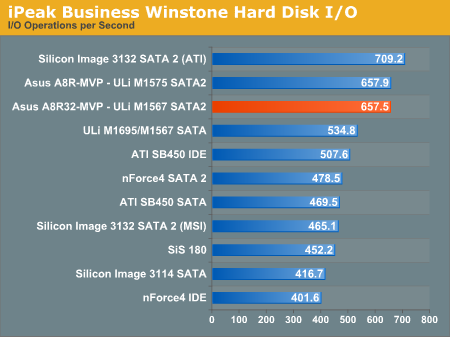
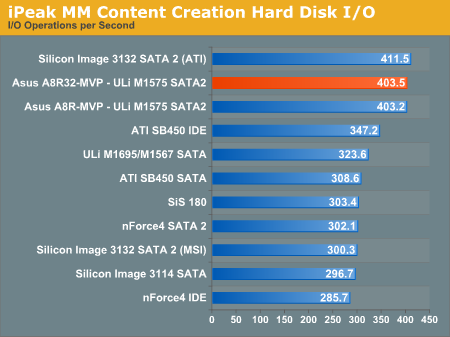
Audio Performance
For audio testing, we used the latest version 2.2 of the Rightmark 3D Sound CPU utilization test. This benchmark measures the overhead or CPU utilization required by a codec or hardware audio chip. Versions earlier than 2.2 would not work properly on the RD580 chipset based A8R32-MVP.
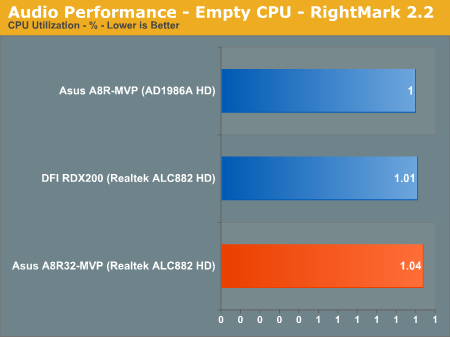
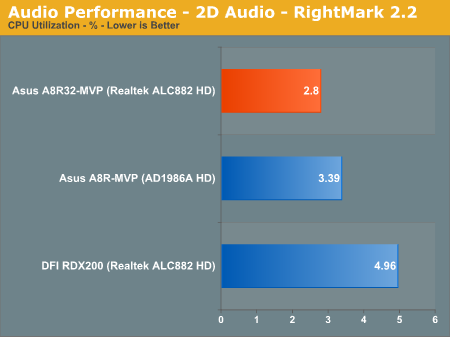
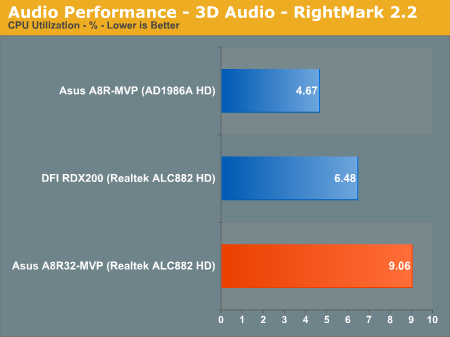
Realtek has been very consistent in recent months in releasing regular updates to their HD audio drivers, and we suspect that trend will continue, with ATI and Intel both firmly committed to HD and NVIDIA also introducing hew HD solutions. Each new Realtek update has lowered CPU utilization and we also hope that will continue.
ATI chipset motherboards have the necessary hooks to deliver Azalia High Definition audio. Those who have been complaining about the poor AC’97 audio present on most AMD boards should be very pleased to find Azalia HD on the ATI chipset boards. The nForce4 family does not offer the necessary chipset hooks to support HD Azalia audio on their top Athlon 64 chipsets. However, recent introductions by NVIDIA have included the HD audio option and we expect future NVIDIA chipsets to offer this feature.
Ethernet Performance
The one area where the Asus A8R-MVP was mildly disappointing was in their choice of an Ethernet controller. Instead of using a PCIe LAN that is capable of providing full 1 Gb bandwidth, Asus used a PCI solution that will be limited in maximum speed by the PCI bus. The A8R32-MVP Deluxe keeps the PCI Ethernet, but it adds a second PCIe Ethernet controller capable of full bandwidth Gigabit LAN.
In practical terms, the PCI bus Ethernet is not much of a roadblock. It caps out about 700 Mb/s compared to the 950Mb/s capability of a PCIe solution. Since most broadband Ethernet connections barely tax 10Mb/s, this will really only matter to those who do sustained high-speed transfer of very large files over a true 1 Gb network - probably less than 1% of users. Still, PCIe Gigabit Ethernet is always a better solution, and it is good to see that Asus addressed this issue in the A8R32-MVP.
The Windows 2000 Driver Development Kit (DDK) includes a useful LAN testing utility called NTttcp. We used the NTttcp tool to test Ethernet throughput and the CPU utilization of the various Ethernet Controllers used on the AMD motherboards.
We set up one machine as the server; in this case, an Intel box with an Intel CSA Gigabit LAN connection. Intel CSA has a reputation for providing fast throughput and this seemed a reasonable choice to serve our Gigabit LAN clients. At the server side, we used the following Command Line as suggested by the VIA whitepaper on LAN testing:
Ntttcps -m 4 ,0,‹client IP› -a 4 -l 256000 -n 30000On the client side (the motherboard under test), we used the following Command Line:
Ntttcpr -m 4 ,0,‹server IP› -a 4 -l 256000 -n 30000At the conclusion of the test, we captured the throughput and CPU utilization figures from the client screen.
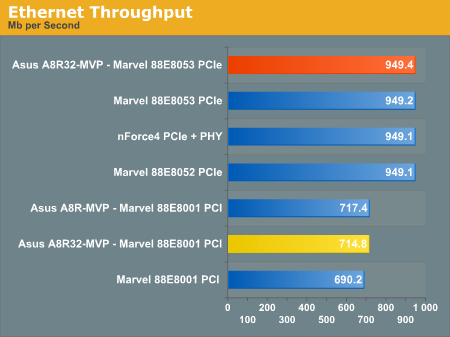
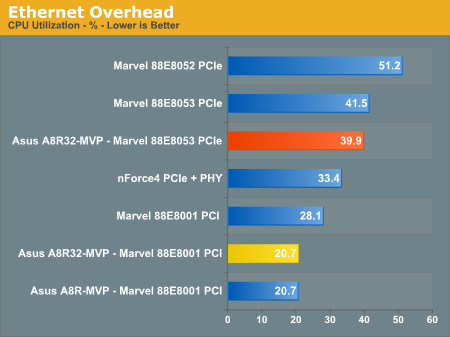
Final Words
The Asus A8R-MVP was a board that was brilliantly positioned by Asus for success. It performed well, overclocked well, and was very cheap. Selling into a market that had no compelling reason for choosing ATI instead, the A8R-MVP had just the right combination of features to attract a large number of buyers.
In some ways, however, the A8R-MVP made promises that it could not keep. The wonderful and fast overclocking required users to adjust down to a 2T Command Rate at high overclocks. Many enthusiasts did not like this requirement, despite the fact the Asus was as fast at 2T as most other boards at 1T. There was always the thought of how much faster it might be at 1T. The other major issue was the very limited vCore overclock options, which many made a bigger deal of than what facts or true performance justified.
Since the launch of the A8R-MVP, however, the AMD market has changed. Now, the ATI X1900XT is the fastest video card on the market instead of the nVidia 7800GTX. Instead of last generation's X850XT Crossfire, ATI's recent X1900XT Crossfire is now the fastest dual video solution that you can buy. The top end of the Socket 939 market is also now moving to dual x16 PCIe and ATI is finally introducing their RD580 dual x16 chipset. This is the chipset that will likely put ATI firmly on the AMD roadmap. Asus appears to understand these changes in the market, and the updated A8R32-MVP Deluxe has been positioned upward. Asus tells us the A8R32-MVP Deluxe is positioned as a high-end board, but the street price will be lower than the nVidia-based dual x16 A8N32-SLI and higher than the dual x8 nVidia A8N. This should translate into a selling price in the $150 to $200 price range once the high introduction prices begin to settle down. While this is higher than the initial estimates, it is still a lower price than the nearest competition based on nVidia chipsets.
In the process of updating the A8R-MVP to the A8R32-MVP Deluxe, Asus has also listened to buyers of the A8R-MVP. With the move to the new rock-solid ATI RD580, Asus has updated just about every complaint with the original A8R-MVP. There are even finer adjustments for many BIOS settings, voltage adjustment options have been greatly expanded from simple on/off to expanded adjustment ranges, the AD1986 6-channel HD codec was replaced by the even better 7.1 channel Realtek ALC882 HD with 103dB S/N ratio, a second full-speed PCIe Gigabit LAN was added, two more SATA2 ports were added with the excellent Silicon Image 3132, and the list goes on. Asus enhanced the A8R32-MVP and moved it from corporate pale brown to Deluxe black. Along the way, the range of BIOS options expanded to one of the best ranges of overclocking controls available on any Asus motherboard. The good things were also kept, like the full SATA2 3Gb/sec ULi M1575 Southbridge instead of the outdated ATI SB450, and the passive cooling without noisy fans on the chipset.
The big question then is: do all the changes improve performance? Based on our tests here, the answer is a resounding "YES". Where the A8R-MVP had to drop to 2T at around 260-265, the A8R32-MVP is stable at 1T Command Rate to 322 in our tests - the highest 1T overclock that we have measured with this processor/memory on air cooling. The board is also solid and exceptionally cool-running, even when pressed hard. We measured a Northbridge temperature of just 109F while looping 3DMarks at over 300FSB; the Southbridge was a similarly cool 107F. This was with passive cooling and the board under high-stress conditions. This performance is really more a compliment to ATI's RD580 chipset than to this Asus design.
The bottom line is that the updated A8R32-MVP is an easy board to love. It will cost more than the A8R-MVP, but it also delivers more. The A8R32-MVP Deluxe provides the best dual x16 video performance that you can currently buy. A pair of X1900XT video cards in Crossfire mode is the current best in video, and the Asus A8R32-MVP drives this video package effortlessly when coupled with an appropriate high wattage power supply. The feature set is competitive with any Socket 939 available and also includes on-board high-definition audio that is not available on current NVIDIA Dual x16 SLI boards. The design is also elegantly simple with an RD580 chipset designed from the ground up for high-speed overclocking and for Dual x16 video.
None of this means that the A8R32-MVP Deluxe is perfect for all users. There will be users who find that 3.2V vDIMM is not enough for their discontinued VX or BH5 memory chips, others will complain that only 1.65V vCore for a 1.35V processor is just not enough to drive their Opteron to 3.x GHz, and some will rightly find fault that there is no usable PCIe slot left if you run Crossfire with dual-slot video cards on this board. However, for most end-users and most enthusiasts, the A8R32-MVP will do exactly what they want to do with their AMD Athlon 64 processor. This even includes some of the highest and most stable overclocks that we have seen on a Socket 939 board.
We will need to see more RD580 boards before we know if the A8R32-MVP is that good or whether it is the RD580 chipset that is the goodness here. We can confess that the A8R32-MVP Deluxe has become a favorite board in the lab in a very short time and it is likely AMD board we would choose today - at least until the AM2 socket late in th esecond quarter, or until that possible killer DFI RD580 comes along. For now, this is a board worth searching out. It looks as if Asus has a young motherboard Engineer on a dynamic development team who is going to give some legends in the industry a run for their money.
Thanks for listening, Asus.

